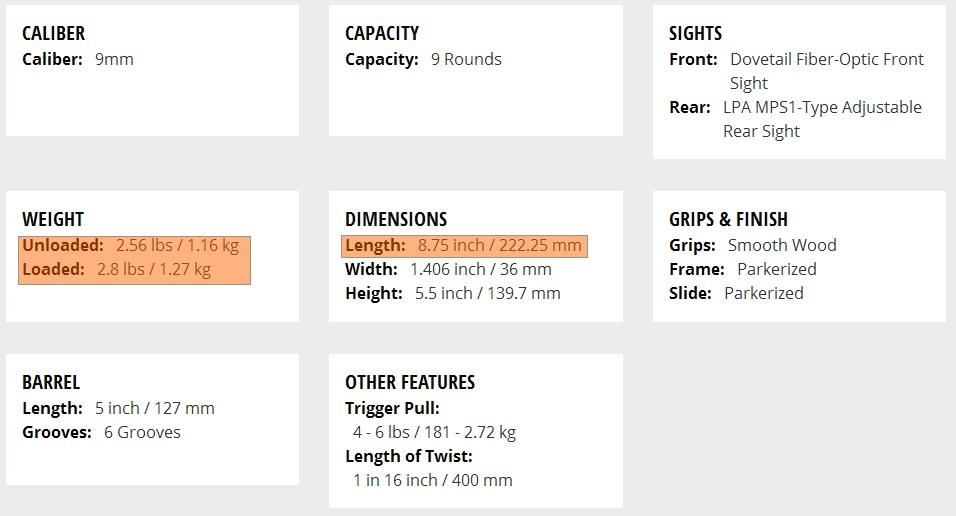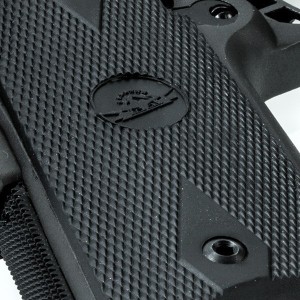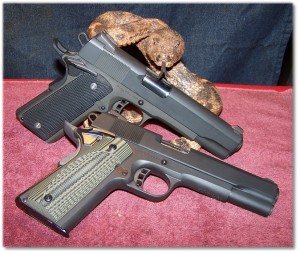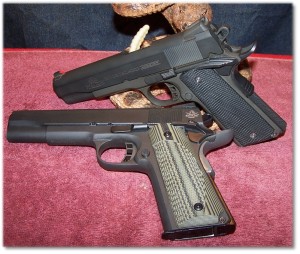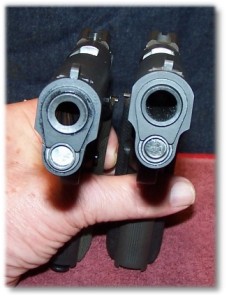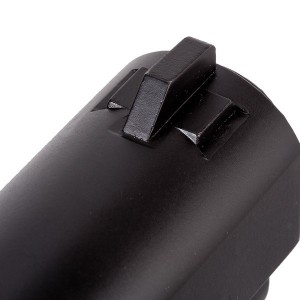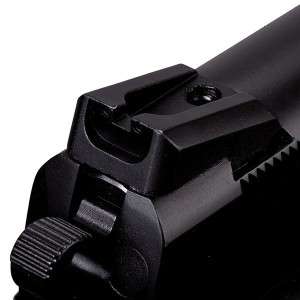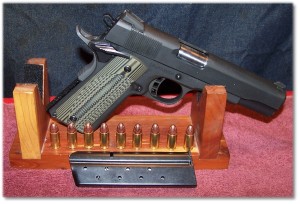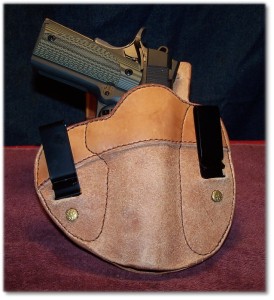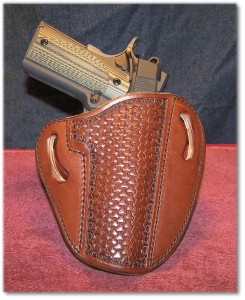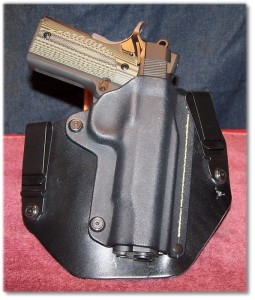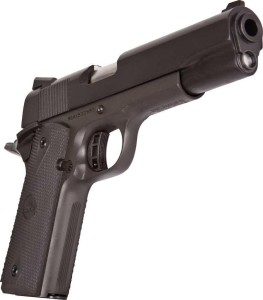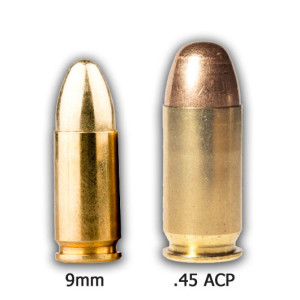 I really wanted to dislike a 9mm version of the 1911. I was actually looking forward to disliking it, which would solidify a statement that I once made to the effect of, “If I need a 9mm pistol that acts like a 1911, I’ll buy a CZ75.” With that highly biased statement made, it led me to realize that since I had not tried a 9mm 1911, how could I justify such a statement? Well, I was about to fix that!
I really wanted to dislike a 9mm version of the 1911. I was actually looking forward to disliking it, which would solidify a statement that I once made to the effect of, “If I need a 9mm pistol that acts like a 1911, I’ll buy a CZ75.” With that highly biased statement made, it led me to realize that since I had not tried a 9mm 1911, how could I justify such a statement? Well, I was about to fix that!
I needed to find a 1911-based pistol in 9mm.
After doing some research, and after I finally talked myself into trying the 9mm 1911 platform, I narrowed the choice down to two that seemed to fit the bill while keeping the outgoing bills for the pistol at a minimum; The Springfield 1911 Range Officer Champion 9mm and a Rock Island 1911 FS 9mm Standard.
There were several differences between the two pistols that helped solidify the final decision:
- Cost – The Springfield 1911 Range Officer Champion 9mm is obviously the higher of the two in cost.
- Barrel systems – The Springfield 1911 Range Officer Champion 9mm uses a “Bull” or tapered barrel that does not require a barrel bushing; whereas, the Rock Island 1911 FS 9mm Standard uses the more conventional straight barrel and barrel bushing.
- Recoil Spring and Guide – The Springfield 1911 Range Officer Champion 9mm uses a Dual Spring w/ Full Length Guide Rod with an internal bushing and the Rock Island 1911 FS 9mm Standard utilizes the single-spring system with a full length guide rod and external bushing.
- Feed System – The Springfield 1911 Range Officer Champion 9mm utilizes a feed ramp that is integral to the barrel (thumbnail feed ramp) whereas the Rock Island 1911 FS 9mm Standard uses the more conventional frame feed ramp.
- Barrel Length – The Springfield 1911 Range Officer Champion 9mm has a 4-inch barrel and the Rock Island 1911 FS 9mm Standard has a 5-inch barrel.
- Frame and Slide – The frame of the Springfield 1911 Range Officer Champion 9mm is Forged Lightweight Alloy (thus the use of the barrel-integrated feed ramp) with a forged steel slide. The Rock Island 1911 FS 9mm Standard, on the other hand, has a forged steel frame and slide.
- Thumb Safety – The Springfield 1911 Range Officer Champion 9mm incorporates a left-side only safety. The safety on the Rock Island 1911 FS 9mm Standard is ambidextrous.
- Finish – The Springfield 1911 Range Officer Champion 9mm and the Rock Island 1911 FS 9mm Standard have Parkerized finishes.
- Grip Safety – The Springfield 1911 Range Officer Champion 9mm and the Rock Island 1911 FS 9mm Standard have beaver-tail grip safeties.
- Sights – the Springfield 1911 Range Officer Champion 9mm comes with Fiber Optic Front & Low-Profile Combat Rear sights while the Rock Island 1911 FS 9mm Standard has a Dovetail Fiber-Optic Front Sight and a LPA MPS1-Type Adjustable Rear Sight; the front or sear sight contains no dots (more on that later).
After a lot of mind-wracking, I decided that I needed to give the 9mm 1911-based pistol a fair shake. Since I already own several Rock Island 1911-based pistols, and carry either the 2nd-generation Rock Island 1911 FS Tactical or a 3rd generation RIA 1911 MS Standard as my EDC, it only seemed logical to me to continue on with a Rock Island Armory (Armscor) product that had the features that I was looking for should I ever decide to carry it. Besides, the Springfield cost about $200+ more dollars and I would not get the key features that I was looking for. Again, that key feature will be presented later.
The Rock Island 1911 FS 9mm Standard, part of the “Rock” series of pistols, follows the convention of the earlier “70” series Colt 1911 with its standard barrel, bushing, and frame-integrated feed ramp. The full-length guide rod (FLGR) is immaterial to me as I can live with them and I can live without them. With the Rock Island 1911 FS 9mm Standard, there is no more complexity with disassembly and assembly of the pistol than with a 1911-based pistol with a standard guide rod. Perhaps, I am just used to them and accept FLGRs as a matter of course. Some of the other RIA pistols (for example, the MS and CS series), which also have full-length guide rods, but are more complex in disassembling and assembling the pistol.
The Rock Island 1911 FS 9mm Standard is much more than your “Standard GI” model. Better sights and better controls are pluses in my book as these modern additions are now “standard” on most 1911-based pistols. I like an extended thumb safety control on a 1911-based pistol and the Rock Island 1911 FS 9mm Standard, as with the Rock Standard FS 45ACP, has what I like. There is virtually no learning transition between these two pistols. There are also a couple of things surprising between the two. The Rock Island 1911 FS 9mm Standard is slightly longer than its .45ACP counterpart and with a full capacity of ammunition it is heavier than the .45ACP version. What this translates to is less recoil and less recoil is always good.
The barrel is a nice piece of work and while most people shun long barrels I like the 5-inch “Government” model barrel length for accuracy and a few more feet-per-second out of the 9mm round (or the .45Acp round, for that matter). Given a 1911-based pistol with identical grip lengths, I can carry and conceal a 1911-based pistol with a variety of barrel lengths. The barrel locks-up securely when in battery. Although I carry a “Commander” length 1911 as EDC, I will swap out with the “Government” length more often than not. The one thing that I like about the RIA series of pistols is the “11-degree Target Crown” barrel. This helps to protect the exit of the barrel from damage.
The provided rubber grip panels with the Rock Island Armory logo are a welcome addition to the new breed of RIA pistols. They are standard width grip panels and the hold on them is very positive, which also helps in recoil management. Grip panels are probably the most changed on 1911-based pistols, and I am guilty as anyone in doing so. With that said, I decided to change the hard rubber grip panels provided with the Rock Island Armory (Armscor) 1911 FS Standard 9mm. After removing the grip panels for cleaning, I noticed that the mounting holes for each rubber panel lacked what I would call a “ledge” – a place for the mounting screws to seal the panels to the frame. Even though I doubted that the grip panels would just fall off of the pistol, I decided to change them out with something, I felt, would be better secured. I had removed a set of new VZ grip panels from the RIA 1911 MS Standard after it was revealed that the grip screws were backing out under recoil. I felt that since the RIA FS 9mm Standard has a lot less recoil, the possibility of the grip screws backing out would be lessened greatly. The VZ grip panels fit the pistol perfectly, look great, provide a good gripping surface, and they have the “Ledge” to ensure that they will seal to the grip frame. If the grip screws do happen to back out under recoil, the blue Loc-Tite will have to be used.
Another feature of the pistol is the vertical serrated lines on the front strap of the grip. Even some higher priced pistols do not have these.
The extended beaver-tail grip safety is also a welcome feature for me. The beaver-tail grip safety enables you to get the hand as high on the grip as possible without worrying about the dreaded “’Hammer Bite” that virtually all 1911 operators have come to know at one time or another. The beaver-tail grip safety is also handy to guide the hand up the grip when drawing from the holster. The “Commander” style roiled hammer nestles nicely in the beaver-tail grip safety and the two are a very workable package.
The Slide Stop lever nicely checkered for positive operation with either the thumb of the firing hand or the thumb of the support hand (which I find myself using more and more).

The Rock Island (Armscor) 1911 FS Standard 9mm Boast an Ambidextrous Thumb Safety – A feature that I now prefer
The one feature of the RIA line of 1911-based pistol (with the exception of their GI series) that I really have come to appreciate is the ambidextrous thumb safety. Many people do not like ambidextrous safeties, but would soon come to appreciate them if they ever have to run the pistol left-handed. The Rock Island 1911 FS 9mm Standard has a substantial ambidextrous thumb safety. While I would like the edges to be more rounded, I have no issues with what comes on the pistol. Note, that I also use a holster that does not have a sweat guard and an extended thumb safety will eventually find its way embedded into the sweat guard. I prefer to have the grip area well clear of anything that could cause the safety to go in the unsafe direction. The ambidextrous thumb safety has a good feel and positively engages and disengages with just the right amount of tension. I would rather have a thumb safety that is a little too stiff than a little too loose.
The first thing that is noticeable when handling the Rock Island 1911 FS 9mm Standard, as compared to its .45ACP counterpart, is how easily the slide functions. Original 1911 recoil springs were sixteen-pounds in spring rate, which was considered normal for the ammunition at the time (230-grain ball running at 850fps). The recommended spring rate for the RIA FS is eighteen-pounds due to more modern ammunition. The standard spring rate for the 9mm version of the full-size (FS) RIA 1911 is twelve-pounds. This spring rate makes the Rock Island 1911 FS 9mm Standard’s slide very easy to manipulate and should appeal to shooters with weak hand strength. The spring rate should also accommodate a wide range of standard range and defensive ammunition (not +P). Although all Armscor pistols are +P rated, the use of this ammunition should be limited (I would also suggest to increase the spring rate to a #14 unit) to prevent damage to the pistol. I’ll be ordering some spare #12 and #14 recoil springs in the near future.
The obvious different between the 9mm version of the 1911 to its larger bored counterpart, the .45ACP, is the bore diameter. The barrel is also thicker to accommodate the slide, which is about the same dimension as the .45Acp version. The thicker barrel also adds weight, which also translates to less recoil. The barrel utilizes the John Moses Browning swing link that, again, reflects the history and tradition of the 1911-based pistol. As with the .45ACP barrel, dual locking lugs in the slide ensure a positive barrel lock-up every time. The barrel has a small feed ramp that tilts down to accept a new magazine-fed round. The cartridges are fully supported within the chamber.
Since the barrel is essentially the same thickness as the .45ACP counterpart, there is going to be obvious difference in the feed ramp. The feed ramp and chamber opening is smaller and it should be obvious that the chamber, feed ramp, and magazine feeding must work in harmony with each other, as they must with a larger caliber 1911-based pistol. It is even more critical with the 9mm version of the 1911-based pistol.
A single 9-round, flush-mount magazine ships with the pistol, and for me, it is the first thing to be replaced after the initial test firing. The ACT-Mag that came with the pistol gave no problems during the test phase for the pistol, but I will be adding Wilson Combat magazines (although expensive) if the pistol is to be used for other than for range practice.
If you are used to three-dot sights (night sights or otherwise), the sights on the Rock Island 1911 FS 9mm Standard may take some getting used to as they have no dots. The front sight; however, is thick enough to view in the notch of the rear sight. I have also noticed that the rear sight contains “pockets” on each side of the viewing area that can be filled with paint or other sight materials to create a two-dot rear sight. Armscor publishes a sight guide on its website (in the FAQA section) to help you when replacing the sights with something better, and I have included the sight dimensions here as well.
The one thing that I can say about the RIA line of 1911-based pistols is that their triggers are consistent; a very short take-up, a wall that takes about 4-pounds of pull to pass (on this particular pistol), a crisp break, and almost nonexistent over-travel. The long, skeletonized trigger incorporates an over-travel adjustment screw. It is a rare case where you would have to adjust this setting, however.
The application of the Parkerized finish is excellent although you may detect difference between component parts of the pistol. This, according to the manufacture is due to varying times in the Parkerizing process, which will result in varying shades of grey almost to black. I have noticed difference in Parkerizing tones in even high priced 1911-based pistols and it comes down to what you can accept and what you cannot.
Finally there is the fit of the slide to the frame. Unloaded, there is a slight hint of movement between the slide and frame, but that is not bad. Once the pistol is locked-n-loaded; however, any trace of movement disappears.
AESTHETICS:
The 1911 pistol has always been aesthetically pleasing, at least to me. The basic lines, look, and feel have all been appealing to me. The second generation (as I call them) of the RIA line of 1911 pistols had a”billboard” of sorts, not unlike many 1911 manufacturers. While this “billboard’ has no affect on functioning, it distracts from the look of the pistol with its stark contrast to the pistol’s finish.
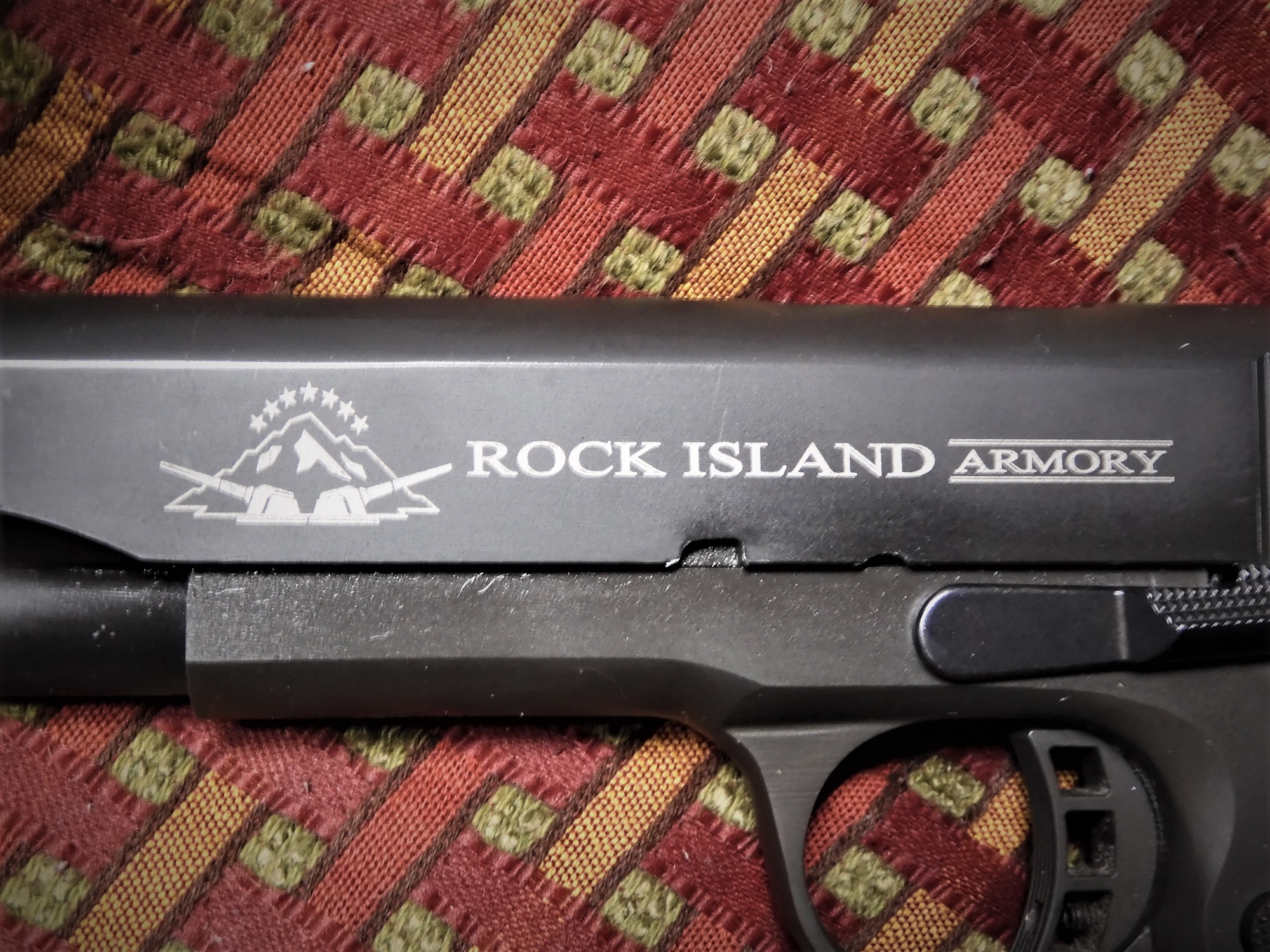
With later models, the large “billboard” was removed. This was replaced with a small logo that is positioned at the rear of the slide.
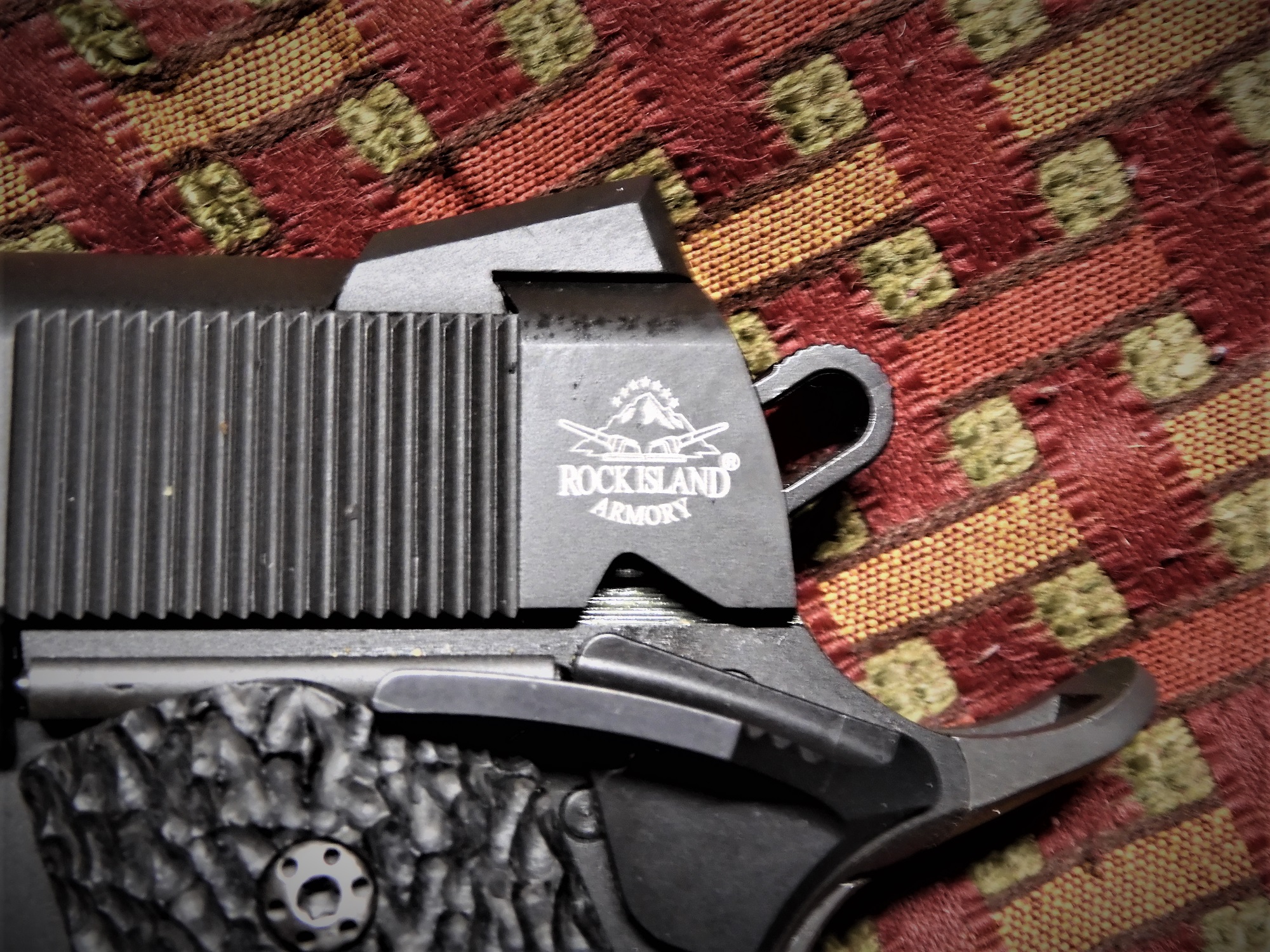
This newer version is far more appealing and still projects the manufacture’s name, but in a more subtle way.
DISASSEMBLY, INSPECTION, CLEANING, LUBRICATING AND ASSEMBLY:
There is no need to go into detail concerning the mechanics of the disassembly, cleaning, lubrication, and assembly of the Rock Island 1911 FS 9mm Standard, as it is pretty much standard with all 1911-based pistols. Since the Rock Island 1911 FS 9mm Standard is a “Government” model of pistol, disassembly and assembly is easily performed without tools, especially since the recoil spring is light as compared to its .45ACP brethren.
Since RIA likes to ship their pistols with an abundance of oil, most of the time was spent trying to get rid of as much of it as I could. The Rock Island 1911 FS 9mm Standard is quite the “leaky” fellow. Especially important was to clean the firing pin and firing pin channel. Brakleen is a wonderful thing to have on hand for this sort of thing.
Lubrication of the pistol was as my usual; Lubriplate NO. 130-A applied to all the rails, guide rod, bushings, and barrel. I did not notice any abnormalities during the inspection and the pistol’s internals passed enough mustering as I could perform. Some say that I am over-lubricating the pistol, but I believe that wherever there is metal-to-metal contact it is to be lubricated. I don’t run my vehicles or my guns without proper lubrication.
When assembled, the Rock Island 1911 FS 9mm Standard felt as slick as Owl… (well, you get the picture) and after working the slide a few times I deemed it worthy of “giving it a go” as they say.
RANGE TIME:
No matter how good a pistol looks, “If it cain’t shoot a lick, it ain’t worth a lick!”
After a tear-down, cleaning, and lubricating the Rock Island 1911 FS 9mm Standard, It was high time to hightail it to the range and see if the Rock Island 1911 FS 9mm Standard was, at least, worth its weight in forged carbon steel.
I had 100 rounds of 124-grain FMJ from Georgia Arms (rated at 1150pfs) that would be used for the initial break-in and function testing. This ammunition is less in energy than some but higher than some others. I felt that it would be a good round to at least “test the waters” of this 1911-based 9mm pistol.
A standard silhouette target was hung at 10-yards, I had a 9mm 1911-based pistol, a full magazine (the magazine that came with the pistol and the only one that I had), and there was only one thing left to do. I wanted to run 50-rounds slow fire, strong hand supported to get a feel of the pistol and establish a POA. Then, change out the target and fire the second 50-rounds strong hand only, strong hand supported, weak hand supported, and weak hand only. I felt that this was the best way to get a full feel for the pistol and allow the pistol to get bedded in with its new owner.
After the shooting session, I walked away with an appreciation of the 1911-based pistol in 9mm. Due to the weight of the pistol, recoil was negligible. If fact, it felt more like firing a .380 caliber round through a light-weight pistol. Since the pistol is a 1911-based pistol, total familiarization of external controls was in place for me. For me, the pistol was an absolute pleasure to shoot.
HOW IT CARRIES:
The beauty of the Rock Island Armory (Armscor) 1911 FS Standard 9mm is that it can be housed in any holster that fits the 1911-based pistol. The weight of the pistol, while not comfortable, is comforting and by virtue of the weight dictates that it be carried in a holster that is well-supported by a good belt. The butt of the pistol, as with any full-size pistol, is the most difficult to conceal. I normally carry a 1911-based pistol in a modified SHTF Gear IWB holster intended for a 5”-barreled (Government model) 1911. The modifications include the removal of the sweat guard to ensure no interference with the thumb safety and adjusting the cant of the holster to place the butt more to the centerline of my body. The holster is worn just behind the right hip and a modified Remora double-pouch ammunition carrier holds two spare magazine just forward of the right hip. In between the holster and the magazine pouch is where I clip my Perry suspenders.
If you are not used to carrying a pistol with any kind of weight to it, carrying one that weighs close to three pounds loaded may seem like a bad idea to you. Consider that the 1911-based pistol was carried long before lightweight pistols came along, and somehow they were carried just fine in holsters far inferior to what is available to us today.
I always wear a T-shirt and my outer shirt is normally unbuttoned and not tucked into the trousers. (This is true even during the hot, summer months.) In cooler weather, I am normally found wearing a non-tactical looking vest of some sort (usually a barn vest). While aiding in concealment, the vest also offers some weight against the pistol that a simple shirt cannot accomplish. The additional weight is necessary for a sweep to the pistol by the shooting hand when it is necessary to engage fire power. In cold weather, I may wear an additional jacket or coat over all; however, the shirt, vest, and outwear all remains unbuttoned as often as possible.
The holster keeps the butt of the gun tight against the bottom of my ribcage so that if I happen to bend at the waist, the outline of the gun butt is minimized due to the modified forward cant of the holster. I am more concerned with concealment than with the weight of the gun.
I have carried the Rock Island Armory (Armscor) 1911 FS Standard 9mm and its brother the Rock Island Armory (Armscor) 1911 FS 45 Tactical from the time I have awoke and dressed until the time I am getting ready for a shower and bed with no ill effects. Once the weight of the pistol is accustomed to, it’s nice to know that you have a full-sized fighting handgun at your disposal. That is not to say that I don’t enjoy carrying a lighter-weight, smaller pistol because I certainly do. But, feeling the heft of the gun and sliding it into the holster doesn’t weigh heavy on my mind, in my hand, or on my hip.
The Rock Island Armory (Armscor) 1911 FS Standard 9mm carries just fine if you are willing to carry it.
SUMMARIZING:
When I have the opportunity to shoot a 1911-based pistol in .45ACP, I pretty much know what to expect by this point in time regardless of the “series” of the pistol. With the 9mm version of this pistol, I expected less recoil, but was not sure of anything else. The Rock Island 1911 FS 9mm Standard is a pleasant surprise. The pistol is low in recoil and high in accuracy (if I do my part). I really don’t think that the Springfield Range Officer Champion could have done any better. The Rock Island 1911 FS 9mm Standard is off to a good start with me.
As I look at this example of an RIA 9mm 1911-based pistol before me, and with two exceptions, I really don’t have the propensity to change anything about it. While I won’t say that the pistol is perfect, the pistol’s weight (which some might say is too heavy), the ease of shooting it, and the familiar feel of its design and current “standard” features appeal to me. The two exceptions are the addition of better magazines and replace the recoil spring with a known spring rate.
Something interesting happened when I ordered this pistol. When I first called my LGS to inquire about it, there were 4 at the warehouse. It took me about 15 minutes or so to review funds and decide to purchase the pistol. In the 15 minutes that it took me to get back with my LGS, two of the four had already been ordered by other LGSs. My LGS placed the order to the distributor as I was on the phone with him to ensure that there would be one available for me.
Is it heavy? Is it big? Is it long? Is it an effective pistol for self defense, target shooting, and/or competition? Why, yes it is on all counts. So, what’s the problem?
I really don’t have any negatives regarding the pistol. Granted I would like to see better sights, but that can be easily fixed. The RIA is a low-end priced pistol, after all. Some may say that the full length guide rod is a negative, but I have no problem with them; the pistol breaks down just as easily as with a 1911 with a standard guide rod arrangement. The hard rubber grip panels are much better than the smooth wooden grips these pistols used to be come with. I would like to see the pistol come with two magazines, but I have no problem keeping good magazine manufacturers in business. And, I have no complaints with how the pistol shoots
Apparently, a 9mm 1911-based pistol is more popular than I was aware of. If you like the 1911 platform, but you also prefer the softer recoiling 9mm cartridge over the .45 ACP, several examples of the 1911-based pistol can be found from Armscor and other manufacturers.
Finally, I have to ask myself, as I do with any handgun, would I be willing to carry the pistol for the purpose of AS or HD? Yes, I would.
UPDATE 02/29/2010:
The RIA 9mm received an update recently; an arched mainspring housing and magwell from Ed Brown, a set of grip panel from VZ grips, and new grip panel mounting screws from Cool Hand Grips.
The arched mainspring housing and magwell from Ed Brown forms the grip to my hand better. I have always liked the arched mainspring housing. The magwell allows me to carry a 10-round 9mm magazine with “Bump Pad” while effectively being concealed by the magwell, although it does add about 1/4″ of length to the grip.
The existing grip panels (also VZ grips) were replaced by a set of Stipple – Full Size Grips that were cut for a magwell and RIA ambi safety. These are secured with custom grip screws from Cool Hand Grips.
The results are shown below.
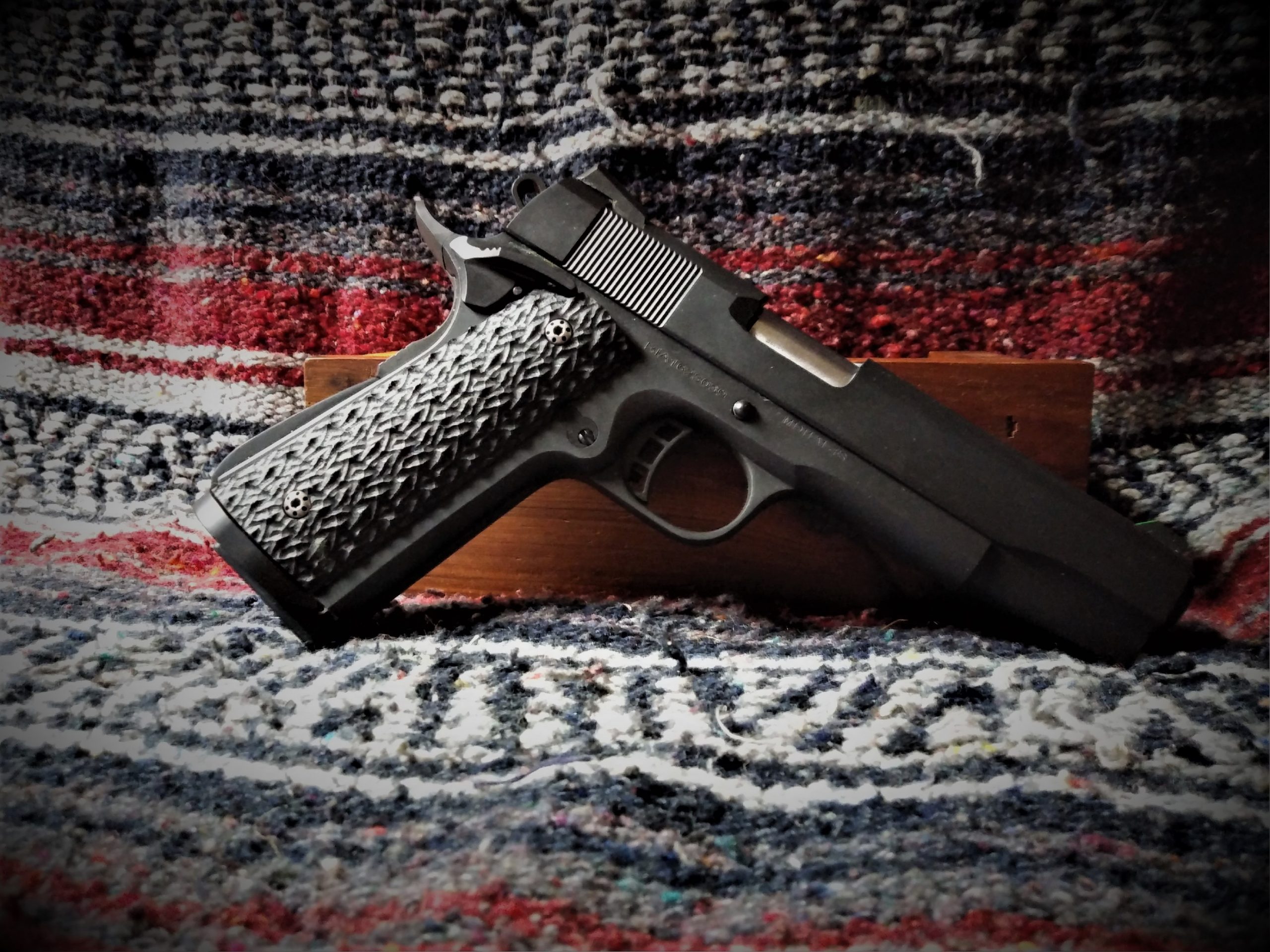
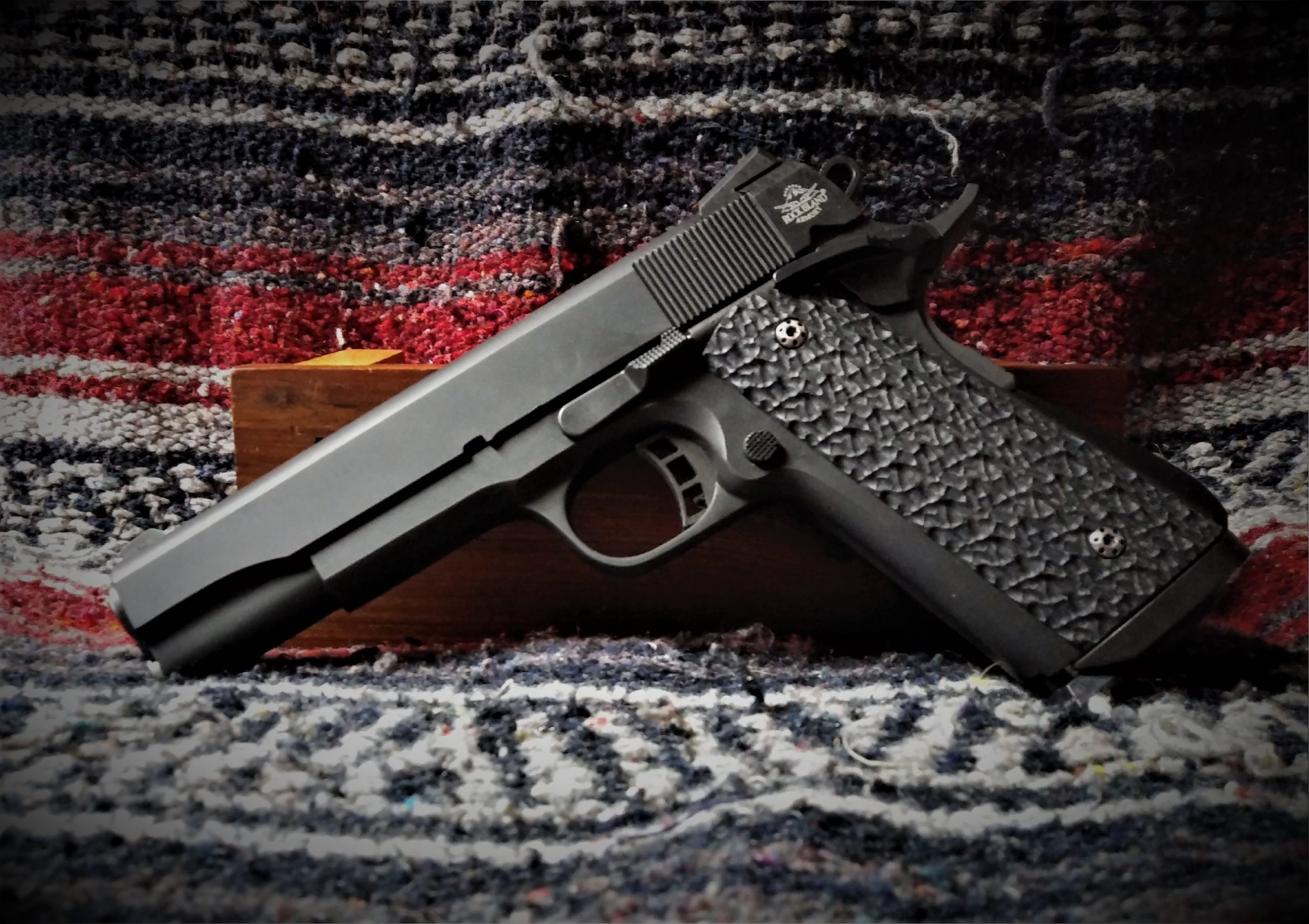
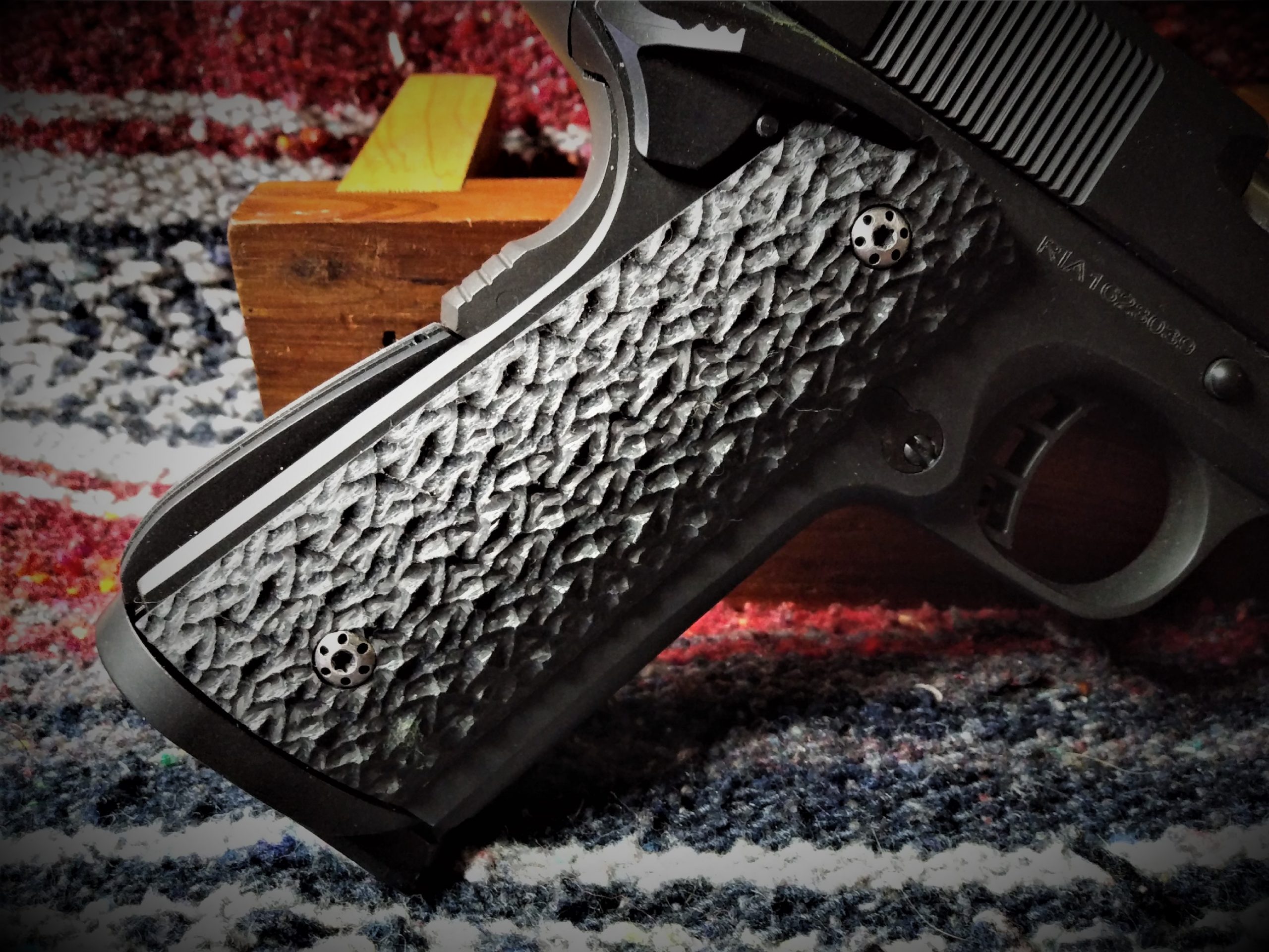
RESOURCES:
- Rock Island (Armscor): http://armscor.com/
- Rock Island Armory (Armscor) 1911 FS Standard 9mm: http://armscor.com/firearms/rock-series/rock-standard-fs-9mm/
- Video review by Hickock45 (Note that the pistol used in the video is the 2nd Generation and which was called the “Tactical” model. This pistol is now called the “Standard” model at the time of this review): https://www.youtube.com/watch?v=dKkloQcBp2M
![]()



